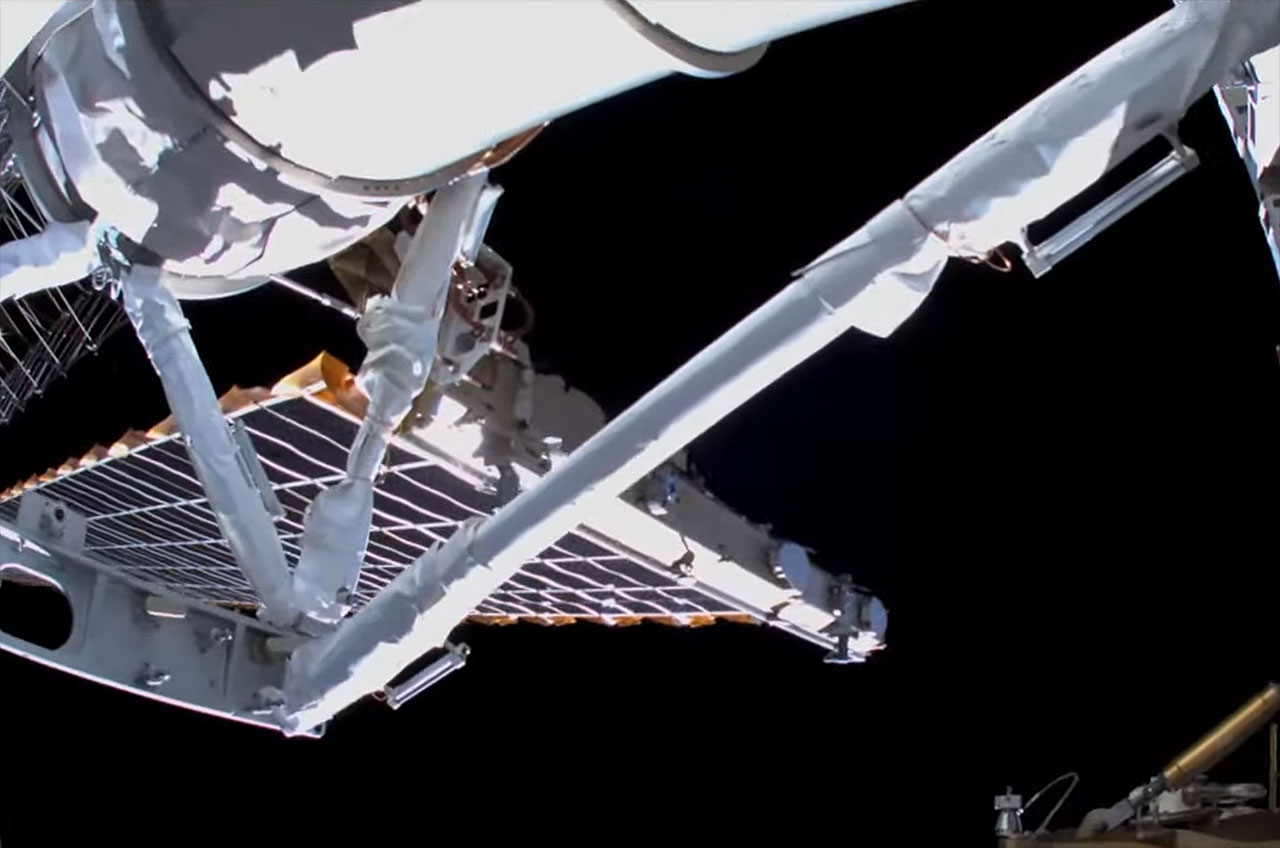Spacewalking NASA astronauts prep space station for new solar array
Kayla Barron and Raja Chari were outside the orbiting lab for nearly seven hours.

The International Space Station is now ready for the addition of an upgraded solar array after two NASA astronauts completed a nearly seven-hour spacewalk on Tuesday (March 15).
Expedition 66 crewmates Kayla Barron and Raja Chari secured brackets and erected struts at the base of one of the space station’s eight original power-providing arrays, preparing the area for the future installation of an ISS Roll-Out Solar Array (iROSA). Their work on the S4 channel of the 3A solar wing deployed the support structure for the third of six new arrays and the first to be added to the starboard side of the space station’s backbone truss.
Barron and Chari began the spacewalk at 8:12 a.m. EDT (1212 GMT) as they switched their extravehicular mobility unit (EMU) spacesuits to internal battery power. The two exited the U.S. Quest airlock carrying the parts and tools they would need for the iROSA kit, prior to making their way to their worksite at the far right side of the orbiting complex.
Spacewalks: How they work and major milestones

The space station’s legacy solar arrays were designed with an on-orbit life of 15 years. Though all are still functioning, they have begun to show signs of degraded power production. The new iROSAs are installed such that they partially overlap the original arrays.
When all six of the more capable iROSAs are installed, they will augment the station’s existing power generation, increasing the complex's total available power from 160 kilowatts to up to 215 kilowatts. The additional power is needed to continue operations through 2030, while also supporting increased commercial activities aboard the station.
In addition to ensuring that the station has the power it needs, the addition of the iROSAs is also serving as a test for NASA's Artemis Gateway to be deployed in orbit around the moon. The Gateway's planned arrays will be longer and be deployed remotely, but otherwise will use the same technology developed by Redwire.
Breaking space news, the latest updates on rocket launches, skywatching events and more!

Completing the prep work for the iROSA installation more than an hour ahead of their planned time line, Barron and Chari were directed by Mission Control to tie back multi-layer insulation on spare battery charge/discharge units to support their robotic replacements or relocations.
For similar reasons and with time to tackle more "get-ahead" tasks, the two astronauts also broke torque and reset bolts on multiple orbital replacement units (ORUs) stored on an exterior platform on the S4 truss segment. The spacewalkers used a power drill called a pistol-grip tool to loosen the bolts holding the ORUs in place on the pallet.
Barron and Chari wrapped up the spacewalk by inspecting the Alpha Magnetic Spectrometer (AMS), a cosmic-ray detector that underwent repairs during a series of challenging spacewalks in 2019. The duo assessed the access to a patch panel for possible further work on the science instrument in the future.
Tuesday's spacewalk came to an end at 3:06 p.m. EDT (1906 GMT), 6 hours and 54 minutes after it began, with Barron and Chari back inside the Quest airlock.
The outing was the second of the year and the 247th extravehicular activity (EVA) in support of the assembly, maintenance and upgrade of the International Space Station since 1998. It was Chari's first spacewalk and Barron's second, bringing her career total time on EVA to 13 hours and 26 minutes.
Another spacewalk is scheduled for March 23 to route coolant hoses and power and data cables, as well as replace an external camera. NASA was waiting to assign the astronauts for that EVA until mangers could assess the outcome of Tuesday's outing.
Follow us on Twitter @Spacedotcom or on Facebook.

Robert Pearlman is a space historian, journalist and the founder and editor of collectSPACE.com, a daily news publication and community devoted to space history with a particular focus on how and where space exploration intersects with pop culture. Pearlman is also a contributing writer for Space.com and co-author of "Space Stations: The Art, Science, and Reality of Working in Space” published by Smithsonian Books in 2018.
In 2009, he was inducted into the U.S. Space Camp Hall of Fame in Huntsville, Alabama. In 2021, he was honored by the American Astronautical Society with the Ordway Award for Sustained Excellence in Spaceflight History. In 2023, the National Space Club Florida Committee recognized Pearlman with the Kolcum News and Communications Award for excellence in telling the space story along the Space Coast and throughout the world.

